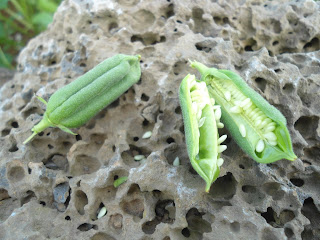"What does a sesame seed grow into?"
Then of course, I wondered why it has taken me so long to wonder that. Of course, the research commenced. So, if you never wondered or just really don't care what a sesame seed grows into, time to go back to CNN, or FOX, or wherever you get your political news fix and get back to being agitated.
Sesame is a flowering plant, native to sub-Saharan Africa. Wild relatives of the plant can be found in India and the Middle Eastern countries. It is now primarily cultivated in China and India, who supply most of the world with these little edible seeds that grow in pods on the plant. Sesame's ability to grow both in drought or monsoon conditions has made it a sustenance crop for poor farmers throughout history.
Sesame is one of the oldest oilseed crops, having been domesticated over 3000 years ago. It has the highest oil content of any seed.
An annual plant, sesame sports tubular flowers, that can be white, yellow, blue or purple. The seeds can also be different colors, from white and tan, to brown, red and black. The seeds are found in a fruit capsule, which when ripe, will naturally split to reveal the seeds, growing in lines. When the split capsules are as dry as possible, the seeds will be harvested, cleaned and hulled.
Sesame seeds appear in cuisines worldwide, and in many different forms. In the Middle East, seeds are ground into a paste called tahini, which is a key ingredient in hummus, and the sauce that tops falafel. In Greece and Sicily, cakes and cookies are made with ground sesame seeds, or topped with them. They show up in Indian, East Asian and West African cooking. The sesame, or as the Africans called them-benne-seeds were brought to America through the slave trade. To this day, benne sticks and benne cookies are staples in South Carolina. They are also found topping burger buns and bagels.
The biggest importer and consumer of sesame seeds, however, is Japan, where they are used in so many ways. They top sushi, salads and snacks, but the most popular use is as sesame oil. Toasted sesame oil is a staple of Japanese cuisine. It is mostly added at the end of cooking to avoid flavor loss and to keep from smoking and tasting rancid. Sesame oil is high in vitamins B1 and E, magnesium, copper, calcium and iron. It is also a source of fiber and good fat.
So now you know the story behind the lowly sesame seed. I know I feel better having this knowledge. And as a parting gift, I shall leave you with a recipe for Benne Wafers. You're welcome.
Benne Wafers
Preheat oven to 375. Line sheet trays with parchment and spray with nonstick spray.
1 c. toasted sesame seeds
3/4 c. melted butter
1 1/2 c. light brown sugar, packed
1 egg, beaten
1 tsp. vanilla extract
1 c. all purpose flour (I like unbleached)
1/4 tsp. salt
1/4 tsp. baking powder
The easiest way to toast sesame seeds is to place them in a sauté pan and heat over medium heat, swirling constantly, until evenly browned. Remove and cool before using.
Combine all ingredients well. Drop by 1/2 teaspoonful onto prepared pans, leaving room between cookies. Bake for 5-6 minutes, or until just browned at the edges. Allow to cool. They will be very flat and crispy.
SAYS-A-WHO? SESAME!!


No comments:
Post a Comment